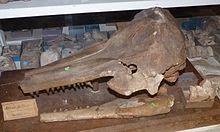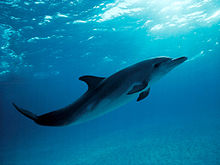Six of the larger species in the Delphinidae, the killer whale, pilot (long-finned and short-finned), melon-headed, pygmy killer and false killer whales, are commonly called whales, rather than dolphins; they are also sometimes collectively known as "blackfish".
Characteristics
The Delphinidae are the most diverse of the cetacean families, with numerous variations between species. They range in size from 1.2 metres (3.9 ft) and 40 kilograms (88 lb) (Haviside's dolphin), to 9 metres (30 ft) and 10 tonnes (killer whale). Most species weigh between approximately 50 and 200 kilograms (110 and 440 lb). They typically have curved dorsal fins, clear 'beaks' at the front of their heads, and forehead melons, although exceptions to all of these rules are found. They have a wide range of colors and patterns.[1]Most delphinids primarily eat fish, along with a smaller number of squid and small crustaceans, but some species specialise in eating squid, or, in the case of the orca, also eat marine mammals and birds. All, however, are purely carnivorous. They typically have between 100 and 200 teeth, although a few species have considerably fewer.
Delphinids travel in large pods, which may number a thousand individuals in some species. Each pod forages over a range of a few dozen to a few hundred square miles. Some pods have a loose social structure, with individuals frequently joining or leaving, but others seem to be more permanent, perhaps dominated by a male and a 'harem' of females.[1] Individuals communicate by sound, producing low-frequency whistles, and also produce high-frequency broadband clicks of 80-220 kHz, which are primarily used for echolocation. Gestation lasts from 10 to 12 months, and results in the birth of a single calf.

Scientists were long aware that Tursiops dolphins might consist of more than one species. Molecular genetics allowed much greater insight into this previously intractable problem. The consensus is two species exist,[3] although a third distinct species was described in 2011:
- The common bottlenose dolphin (T. truncatus) is found in most tropical to temperate oceans; its color is grey, with the shade of grey varying among populations; it can be bluish-grey, brownish-grey, or even nearly black, and is often darker on the back from the rostrum to behind the dorsal fin.[4]
- The Indo-Pacific bottlenose dolphin (T. aduncus) lives in the waters around India, northern Australia, South China, the Red Sea, and the eastern coast of Africa; the back is dark-grey and the belly is lighter grey or nearly white with grey spots.[7]
- The Burrunan dolphin (T. australis), found in the Port Phillip and Gippsland Lakes areas of Victoria, Australia, was described in September 2011 after research showed it was distinct from T. truncatus and T. aduncus.[8]


No comments:
Post a Comment
Note: Only a member of this blog may post a comment.